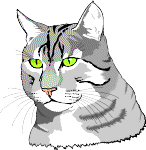|
If sheer number were the criterion, then the cat would
be considered the most popular pet in North America (sorry dog lovers!)
According to United States Census data, there are over 60 million household cats
in that country. Careful estimates
also place free-ranging, feral cats at an additional 40 million, for a total
population of 100 million felines. Canada
has a similar percentage of households with cats, but the feral population is
much lower due to our harsh winters. |
 |
|
|
The cat has been regarded with a unique mixture of
adoration and awe since the species was first domesticated in ancient Egypt some
four thousand years ago. Though the
cat is now kept mostly as a pet, historically it was bred and used exclusively
to curb rodent populations in grain storage areas.
There are many recognized breeds of domestic cat that differ widely in
appearance, but they all share one common characteristic....each has retained
the hunting instinct of their wild forbears.
This fact has far reaching implications for our small mammals and birds.
The National Audubon Society estimates that feral and
free-roaming domestic cats kill hundreds of millions of native birds ( ...
sadly, even endangered species), and even greater numbers of small mammals
(squirrels, mice, voles, rabbits) annually in North America. As non-native predators, cats wreak havoc in natural
ecosystems that have had little time to evolve effective defense mechanisms.
When it comes to killing it doesn't seem to matter if a cat is well cared
for. One U.S. study documented the
activity of a well-fed domestic cat that killed 1600 small animals and birds in
an 18-month period. Popular
measures used to mitigate the impacts cats have on wildlife (declawing, collars
with bells, etc.) are believed to be relatively ineffective.
There are other negative effects associated with
free-roaming and feral cats. For
instance, cats displace native predators by reducing prey availability. They can
also act as significant disease (rabies, feline distemper, etc.) vectors to both
wild and domestic animal populations. It
is also a fallacy to believe that cats somehow benefit from having the freedom
to roam. The Toronto Humane Society
estimates the average life span of an outdoor cat to be around three years,
compared to 16-20 for an indoor cat. This
discrepancy is largely due to car-related fatalities (l.5 million cats are
struck by cars annually in the USA), disease, dogs, coyotes, and great horned
owls.
Veterinarians & many naturalists agree that the
solution is simple and clear: for the sake of both cats & wildlife, cats
should be kept indoors.
|